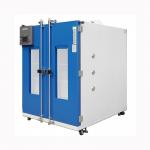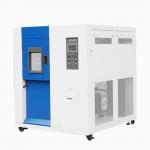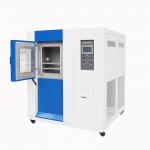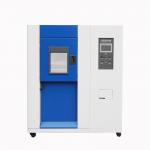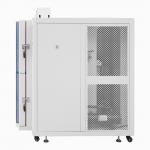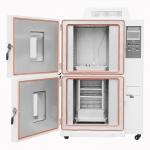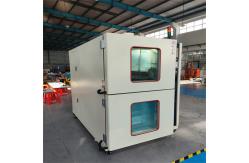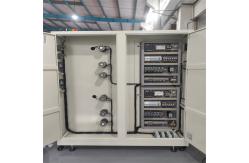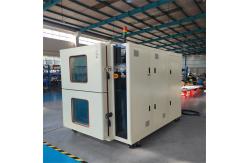In the world of modern manufacturing and product development,
ensuring the durability and reliability of products under various
environmental conditions is of paramount importance. The 80L high
and low temperature simulated climate conditions two-zone thermal
shock test chamber emerges as a powerful tool that meets the
stringent demands of multiple industries. This advanced test chamber, with a capacity of 80 liters and a
unique two-zone design, is specifically engineered to subject
products and components to rapid and extreme temperature changes.
It serves industries such as aerospace, automotive, electronics,
and telecommunications. The primary purpose is to replicate the
harsh thermal shock conditions that products may encounter during
their lifecycle, including manufacturing processes, transportation,
and in-field operation. By accurately simulating these conditions,
manufacturers and researchers can identify potential weaknesses,
optimize product designs, and ensure compliance with industry
standards and regulations. - Robust and Efficient Design
- The chamber is constructed with a heavy-duty framework, typically
made of high-strength steel, to withstand the rigors of continuous
thermal shock testing. The exterior is designed to be both durable
and space-efficient, making it suitable for integration into
laboratory or production line setups. The interior is divided into
two distinct zones - a high-temperature zone and a low-temperature
zone. Each zone is lined with a non-reactive and smooth surface,
such as stainless steel or a specialized thermal insulation
material, to prevent any interaction between the chamber and the
tested specimens. The two-zone configuration allows for rapid
temperature transitions as samples can be quickly moved between the
zones. The doors of the zones are engineered for a tight seal,
featuring reliable locking mechanisms and heavy-duty gaskets. They
also include viewing windows, usually made of tempered glass with
anti-fog and anti-scratch properties, enabling visual monitoring of
the testing process without disturbing the internal temperature
environment.
- Precision Temperature Control Systems
- High-Temperature Zone: The high-temperature system can reach
temperatures up to +200°C or even higher, with an accuracy of
±0.5°C. It utilizes advanced heating elements and a sophisticated
temperature control loop, along with multiple strategically placed
temperature sensors. This ensures rapid and uniform heating of the
samples, essential for effective thermal shock testing. The system
also has built-in safety features to prevent overheating and
protect both the samples and the chamber components.
- Low-Temperature Zone: The low-temperature system can achieve
extremely cold temperatures, typically down to -70°C or lower, with
an accuracy of ±0.5°C. It employs advanced refrigeration
technologies, such as cascade refrigeration, and a well-designed
temperature control mechanism. The chamber is equipped with a
powerful circulation system to ensure even cold air distribution.
Similar to the high-temperature system, it has safety features to
avoid overcooling and safeguard the integrity of the testing
environment.
- Temperature Transition: The key feature of this chamber is its
ability to rapidly transition samples between the high and
low-temperature zones. The temperature change rate can be as fast
as 15°C to 25°C per minute, allowing for a highly realistic
simulation of extreme thermal cycling. The control panel enables
users to program and adjust the temperature profiles, including the
duration of each temperature stage, the number of cycles, and the
rate of temperature change.
- Advanced Instrumentation and Data Acquisition
- The chamber is equipped with a comprehensive suite of sensors.
Temperature sensors are distributed in each zone to monitor the
temperature at different locations, ensuring that the samples
experience the desired temperature conditions uniformly. These
sensors are connected to a state-of-the-art data acquisition system
that records and stores all the temperature data. The data can be
accessed and analyzed in real-time or retrieved later for in-depth
studies. The data acquisition system is highly flexible and can be
integrated with external software and databases, facilitating
seamless data transfer and analysis. It can also be configured to
send notifications and reports automatically, saving time and
effort for the users. Additionally, the control panel includes
built-in alarms and safety features that alert users in case of any
abnormal temperature conditions, power failures, or equipment
malfunctions.
- Volume and Dimensions: With an 80-liter capacity, the interior dimensions of each zone
are carefully optimized to ensure proper air circulation and
temperature distribution. The external dimensions are configured to
fit within a standard laboratory or production area, typically with
a width of around 100 to 120 centimeters, a depth of 80 to 100
centimeters, and a height of 150 to 180 centimeters, depending on
the specific design and manufacturer.
- Temperature Uniformity: The temperature uniformity within each zone is maintained within
±1°C during both high and low-temperature conditions. This ensures
that all parts of the tested samples experience a similar thermal
environment, which is crucial for obtaining accurate and reliable
test results.
- Temperature Stability: Both the high and low-temperature systems offer excellent
temperature stability, with minimal fluctuations over time. This
allows for consistent and repeatable testing, enabling
manufacturers to compare results accurately and make informed
decisions about product improvements.
- Temperature Change Rate: The chamber can achieve a rapid temperature change rate,
typically ranging from 15°C to 25°C per minute, depending on the
specific requirements and settings. This fast transition capability
is essential for simulating real-world scenarios where products may
be exposed to sudden temperature changes.
- Accurate Simulation of Harsh Thermal Environments
- The primary function of this chamber is to provide a highly
accurate and realistic simulation of thermal shock conditions. By
precisely controlling the temperature transitions, it allows users
to evaluate how products and components will behave in various
thermal stress situations. For example, in the aerospace industry,
it can test the performance of avionics systems, engine components,
and structural materials under the extreme temperature changes that
occur during flight. In the electronics industry, it can assess the
durability of circuit boards, microchips, and connectors under
rapid temperature fluctuations.
- The ability to program complex temperature profiles, including
multiple cycles of high and low-temperature shock, is also a
valuable function. This can help in uncovering potential weaknesses
or failure points in products that may not be evident under static
temperature testing. For instance, a product that functions well at
a constant temperature may develop cracks or experience performance
degradation after several cycles of thermal shock, and this chamber
can accurately replicate such scenarios.
- Enhanced Product Quality and Research Capabilities
- Through comprehensive testing in the chamber, manufacturers can
identify and address potential issues in their products. If a
product shows signs of degradation or failure under specific
thermal shock conditions, appropriate measures can be taken, such
as modifying the design, changing the material composition, or
improving the manufacturing process. This leads to the development
of more stable and reliable products, reducing the risk of failures
and recalls. In the research field, it allows for the exploration
of new materials and the understanding of their properties under
extreme thermal cycling, which can lead to significant scientific
breakthroughs.
|
